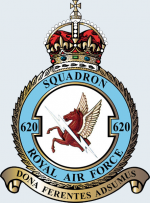
Badge: In front of a demi-pegasus couped, a flash of lightning
Motto: ‘Dona ferentes adsumus’ (‘We are come, bringing gifts’)
HISTORY
Squadron Code Letters ‘QS’ & ‘D4’.
No.620 Squadron formed in No.3 Group of Bomber Command at Chedburgh, Suffolk, on 17 June 1943, 10 Stirlings from each of Nos 149 and 214 Squadrons, and two days later, on 19/20 June, it began operations with an attack by eight Stirlings on the Schneider armament works at Le Creusot in France. During the next four months it bombed several industrial centres in Germany and also carried out many minelaying operations.
After a final bombing mission, against Leverkusen, in Germany, on 19/20 November 1943, the squadron’s role was changed to that of airborne support. It was transferred to No.38 Group, Allied Expeditionary Air Force and moved to Leicester East where an intensive training programme began. (In five months of bomber operations, the squadron had lost a total of twenty six aircraft; at least nineteen more were to be destroyed in their new role). The chief features were day and night cross country navigation exercises and glider-towing practice, and by February 1944 the squadron was ready to undertake the first of the special operations for which it had been earmarked-supply-dropping to the Resistance movement in France. In March 1944 the squadron moved to Fairford, Gloucestershire, where more glider-towing and parachute-dropping was practised.
No.620’s greatest moment came on ‘D-Day’ when its Stirlings Mk IVs (23 aircraft for Operation ‘TONGA’) by now-dropped a considerable part of the 6th Airborne Division’s paratroops near Caen. 3 aircraft failed to return (EF295 of Squadron Leader PETTIT OBE DFC, EF268 of Pilot Officer CASKEY, EJ116 of Flight Sergeant BARTON) and 4 were damaged. The following day the squadron towed part of the glider-borne force to the same area (18 Stirlings, Operation ‘MALLARD’; one aircraft, LJ849 of Flight Lieutenant THOING, crash-landed in a field but Flight Lieutenant THOING escaped and returned, later with his crew), and when these tasks were complete it resumed its supply drops to the French Resistance; it also continued re-supply operations to our own ground forces in the battle area. In August a bombing attack, the squadron’s first for nearly a year, was made on a special target in southern France.
In September 1944 the full strength of the squadron was mustered for the Arnhem operation in which it dropped and towed the first paratroops (in towed gliders were elements of the 1st Airborne Division). Thereafter the squadron continued to drop supplies during this ill-starred airborne operation for as long as it was able to do so. During one of these missions the Commanding Officer, Wing Commander LEE DFC, was shot down. He was rescued by patriots and returned to the unit within a matter of hours (109 sorties had been flown until 24 September, 5 aircraft had failed to return: LK127 of Flying Officer SCANLON & LK548 of Pilot Officer McHUGH on 20 September, LJ830 of Flying Officer McLEOD & LJ946 of Pilot Officer CAREY on 21 September; LJ873 of Wing Commander LEE DFC on 23 September).
In the text few months the need for airborne supply operations diminished and No.620 resumed bombing on a considerable scale, although this was interspersed with occasional supply drops over Holland and Norway.
On 24 March 1945, Operation ‘VARSITY’, the final great airborne operation of the war took place when the Allied armies reached the Rhine. No.620 Squadron towed 30 Gliders (138 troops plus many vehicles) from Great Dunmow, Essex, to the Rhine with loads consisting mainly of anti-tank and artillery units. This was done without loss and only one glider failed to reach the target, owing to a broken tow rope.
A few more supply drops were made over Holland and Scandinavia in April and May 1945 and liberated British prisoners of war were flown home from the Continent. Troops and supplies were carried to Norway, and in the weeks immediately following VE Day the squadron operated a troop-carrying service between the UK and Brussels. Meanwhile, the Stirlings had been replaced by Halifaxes and No.620 continued with these until 01 September 1946, when it was renumbered No.113 Squadron at Aqir, in Palestine, where it had been based for several months.

Commanding Officers
17 June 1943 Wing Commander D.H. LEE DFC, LeoP(O), CdeG(1940)(P)(B)
(Shot down in Operation “Market” on 23 September 1944)
LeoP(O): Order of Leopold (Officer) with Palm – Belgium
CdeG(1940)(P)(B): Croix de Guerre 1940 with Palm – Belgium
04 October 1944 Wing Commander G.T. WYNNE-POWELL DFC
01 July 1945 Wing Commander G.H. BRIGGS DFC
27 July 1945 Wing Commander K.R. SLATER AFC
August 1945 Wing Commander N. ALEXANDER DFC

Date / Base / Aircraft
17 June 1943 Formed at Chedburg No.3 Group Bomber Command
17 June 1943 / Chedburg / Stirling I, Stirling III
August 1943 Stirling I is retired
August 1943 / Chedburg / Stirling III
22 November 1943 To Leicester East detachment Hurn / Stirling III Transferred to No.38 Group
February 1944 / Leicester East / Stirling III, Stirling IV
March 1944 Stirling III is retired
18 March 1944 To Fairford / Stirling IV
18 October 1944 To Great Dunmow / Stirling IV
July 1945 Stirling IV is retired
July 1945 / Great Dunmow / Halifax A.VII
15 January 1946 To Aqir / Halifax A.VII
06 March 1946 To Cairo West detachment Shalluffa / Halifax A.VII
14 June 1946 To Aqir / Halifax A.VII
June 1946 / Aqir / Halifax A.VII, Dakota
August 1946 / Aqir / Halifax A.VII, Halifax A.IX, Dakota
01 September 1946 Squadron disbanded (renumbered as No.113 Squadron)
Next page: 644 Squadron

